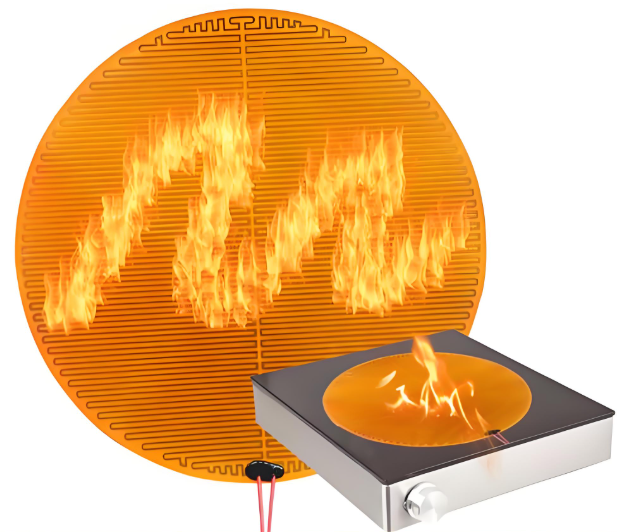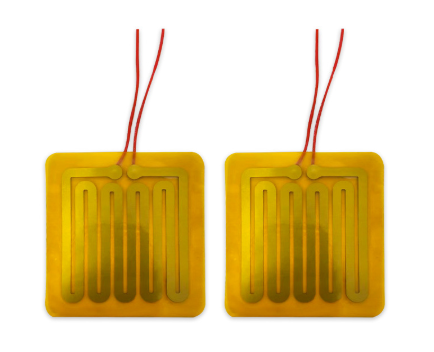PI heaters, also known as polyimide film heaters or Kapton heaters, are well-known for their flexibility, lightweight structure, and excellent thermal performance. They are widely used in applications such as aerospace, medical devices, and battery heating systems. When designing or selecting a PI heater, power density is one of the most important parameters to evaluate. It directly affects heating speed, efficiency, and the overall safety of the system.
So, how can we determine the right power density for a PI heater? And does a higher power density always mean faster heating? Let’s explore these questions in detail.
Power density refers to the amount of power distributed per unit area of the heating element. In simple terms, it is the heating power (W) divided by the surface area (cm²).

In a PI heater, the power density determines how much heat is generated over a specific area. The higher the power density, the faster the heater reaches its target temperature. However, it also increases the risk of overheating if not properly controlled.
Under dry conditions (without heat dissipation or airflow), the maximum power density for a PI heater is typically 1.2 W/cm². This is considered a safe value for most applications.
However, for small-sized PI heaters, the power density can be slightly higher—up to 3 W/cm²—when used with proper temperature control systems. The reason is that smaller heaters have less thermal inertia and can dissipate heat more evenly.
In comparison:
This difference is mainly due to material properties. PI film has higher thermal stability and can operate continuously at elevated temperatures.

Yes, power density is closely related to heating speed. A higher power density means more energy is delivered per second, which results in faster temperature rise.
For instance, a 1 W/cm² PI heater can reach up to 300°C. If you want to reach 200–250°C within 10 seconds, the required power density may need to be between 2–3 W/cm².
However, there are limits. When power density exceeds the material’s thermal tolerance, it may cause uneven heating, shorten heater lifespan, or even lead to failure. That’s why engineers rarely go beyond 3 W/cm², even for fast-heating designs.
As the power density increases, temperature control becomes critical. A temperature controller helps regulate power output and prevent the heater from overheating.
For high-power-density heaters, it’s recommended to use a closed-loop control system with sensors such as thermistors, RTDs, or thermocouples. These devices monitor real-time temperature and adjust voltage or current accordingly.
Without such control, a PI heater running at 2–3 W/cm² could easily exceed safe temperature limits within seconds, potentially damaging the substrate or components nearby.

To determine the suitable power density for your PI heater, consider the following factors:
In general, start with 0.8–1.0 W/cm² for most PI heater designs, and adjust upward only when faster response or higher temperature is required.
Example of How to Calculate Power Density of a PI Heater
Suppose you need to design a PI heater with:
Then the power density is:

This falls within the standard safe range. If you increase the power to 100 W, the power density becomes 2 W/cm², which requires a temperature control device to prevent overheating.
| Heater Type | Material | Max Power Density (W/cm²) | Max Temperature (°C) | Recommended Control |
| PI Heater | Polyimide | 1.2 (up to 3 with control) | 300 | Required above 1.2 |
| Silicone Heater | Silicone Rubber | 2.0 | 200 | Recommended |
| Transparent Heater | ITO / PET | N/A | 100 | Optional |
This table shows that PI heaters offer excellent thermal performance with moderate power density, ideal for precision applications requiring thin and flexible designs.
1. Ignoring temperature control: Operating at high density without regulation may cause burnout.
2. Uniform density assumption: Uneven trace layout can create hot spots.
3. Overestimating power needs: Higher power isn’t always better; it may damage materials or reduce lifespan.
4. Neglecting environment: Airflow and surface contact affect heat distribution significantly.
Determining the power density of a PI heater is not just about reaching a target number. It’s about finding the right balance between heating speed, temperature control, and safety. Generally, PI heaters can operate up to 1.2 W/cm² safely, and smaller heaters can reach 3 W/cm² with advanced temperature control.
When you need consistent, uniform heating with compact size and lightweight construction, PI heaters are among the best solutions.
At Danyu Electronics, we specialize in custom PI and silicone heaters with precise resistance control and tailored power density design. Our engineering team provides full support — from prototype to mass production — ensuring your heating system delivers stable, efficient, and long-lasting performance.
1. What is the safe power density for most PI heaters?
Usually between 0.8 and 1.2 W/cm² under normal working conditions.
2. Can I increase the power density for faster heating?
Yes, but it requires a good temperature control system to avoid overheating.
3. What temperature can PI heaters reach?
They can typically reach up to 300°C, depending on the design.
4. How to control the temperature of a PI heater?
By integrating temperature sensors such as thermistors or RTDs and using a PID controller.
5. Are PI heaters suitable for outdoor or vacuum environments?
Yes. Their stable insulation and moisture resistance make them suitable for such conditions.
Simply drop your email or phone number in the contact form, and we'll promptly reply you shortly.